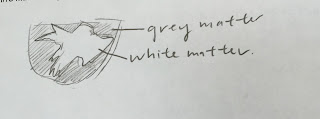In this lab, we tested out numerous types of reflexes, including the photo pupillary reflex, the knee jerk reflex, the blink reflex, the babe, and what's your sign reflex. Proceeding this, we tested our response times to catching a falling meterstick while texting and without it. In our notes, we learned that neurons are responsible for transmitting various messages from one area of the body to another while reflexes are involuntary actions that that the body does as a response to various stimuli. We also learned that a reflex arc is a nerve pathway.
The Reflexes
A. The Photopupillary Reflex
Claim: As there is an increased amount of light entering the eye, there is a photopulillary reflex which causes the iris's colliery body to be stimulated. This causes it to contract. This results to the pupil decreasing in size due to the decreased amount of light entering the eye.
Evidence: My partner covered her eye with a hand for a few minutes and after, we shined a flashlight close to an eye. The pupil's size decreased due to the decreased amount of light entering the eye.
B. Knee Jerk Reflex
Claim: The knee jerk reflex transfers from the sensory neurons to the spinal cord and the motor neuron and finally to the knee. The knee jerk reflex is also called the monosynaptic reflex since only a single synapse in the circuit is required with the reflex. We were able to see this after repeated attempts of using the reflex hammer to find the correct part on the knee.
Evidence: After several repeated attempts of my partner bruising my knee with a reflex hammer, my knee was able to kick out after she hit the right part of the knee.
Reasoning: The reflex hammer causes a stretch in the thigh muscle which causes information to be sent to the spinal cord. Shortly after, the synapse is sent to the ventral horn in the spinal cord and goes back to the thigh muscle.
C: Blind Reflex
Claim: The blind reflex is a result of the eyelid automatically closing after something rapidly comes to the eye. This was observed after both my partner and I blinked when cotton balls were thrown at us.
Claim: The blind reflex is a result of the eyelid automatically closing after something rapidly comes to the eye. This was observed after both my partner and I blinked when cotton balls were thrown at us.
Evidence: I held up a piece of saran wrap and my partner threw a cotton ball at me and I blinked. My partner also blinked when we reversed roles, showing the
effects of the blink reflex.
Reasoning: On average, people blink 15 times per minute or 14,400 times a day and by blinking, we are able to prevent small pieces of dust and other objects from entering our eyes.
Part 4: Babe, what's your sign
Claim: The plantar reflex occurs when the sole of the foot is stimulated using a blunt object e.g. a pen cap. When we dragged a pen from the sole of the foot to the base of the big toe, we noticed that our toes not only moved closer together but also flexed.
Claim: The plantar reflex occurs when the sole of the foot is stimulated using a blunt object e.g. a pen cap. When we dragged a pen from the sole of the foot to the base of the big toe, we noticed that our toes not only moved closer together but also flexed.
Evidence: After taking off my shoes and socks, my partner took a pen with a cap and dragged it from the heel to the base of the big toe. We observed that the toes flexed and moved more closely together.
Reasoning: This reflex is a response when the body receives a specific stimuli, showing that the plantar reflex works properly in our bodies. When there is nerve damage, there is a possibility that the toes will spread apart and upward; this is called Babinski's sign.
Part 5: How Fast are You?
In this activity, we tested reaction time, in which our brain transferred a motor command to the arm/hand muscles. I had my partner hold the highest part of a meterstick and let it hang down while I put my hand on the bottom and was ready to catch the ruler. We documented the level at which we caught the meterstick. After three trials, we took the average time and used the table on the lab to convert the distance into the number of milliseconds.
While my partner's time was .13 seconds, my time was .25 seconds. We perceived that the difference in time was primarily caused by the fact that my partner spends a large portion of her time playing softball; as a pitcher, she requires quick reflexes in order to avoid being hit by the ball.
We redid the test again while texting; we realized that our times increased. For instance, my partner's time went up to .185 seconds while my time was .26 seconds; this shows that although while answering a text may appear to be important while texting, it can cause a delay in reaction time, which may cause a crash to occur.
Class Table:
 |
| Our class's results for "How Fast are You?" |





































